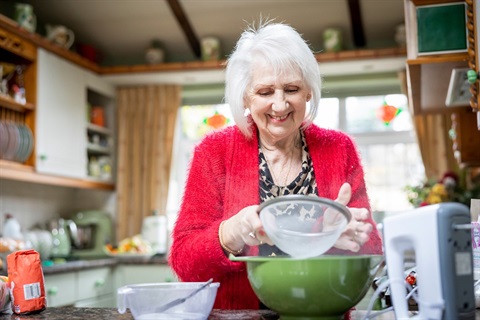How to create a dementia-friendly home
Published on 18 September 2023

Following a dementia diagnosis, an important conversation to be had early on is whether this person will continue to live at home or move into an assisted care facility. This can be a very hard decision for those people living with dementia and their families and loved ones to make, and the best option is always going to be dependent on personal circumstances.
For many people, the desire to continue living at home can be very strong, and the arguments for choosing to receive care at home are quite compelling. People with dementia tend to benefit from being in familiar environments, where they are surrounded by photos, personal items and positive memories. This familiarity can lead to reduced levels of anxiety and confusion, and improved levels of safety and comfort.
Additionally, living at home and receiving home care can help to support the independence of people living with dementia. For example, some people can continue to make choices for themselves at home and feel a level of control over their day-to-day actions. It can also be easier to build routines in a familiar environment like your own home, which is critical to reducing stress, anxiety and confusion.
To ensure that people with dementia can continue living at home for as long as is possible, it’s important that their home environments are well-designed. This can mean making a few minor modifications around the house that will support people to feel safe, secure and in control.
“I find that advice on adjustments to make around the home is most effective when it’s tailored to an individual’s needs,” says Kate, AccessCare’s Community Nursing Team Leader. “Most carers will make modifications and changes as issues arise, so it’s important to always stay vigilant and notice when your loved one’s needs or habits change, as this is a good indicator that new supports are required.”
Below is an overview of some of the ways to help create a more dementia-friendly home.
Improve lighting around the house
By replacing current light globes with brighter ones and installing sensor lighting in rooms such as the bathroom, you can help to reduce the risk of falls, especially at night.
You should also make use of natural light as best you can, so set up reading nooks by the brightest windows, and always open curtains and blinds fully to invite sunshine into the home as much as possible.
Additional table and reading lamps are also worth considering, especially touch lamps, but do be mindful of the placement of electrical cords, as these could become tripping hazards.
Add useful contrasts around the home
To help people to move more easily around their home, you can consider painting doors, door handles and door frames in contrasting colours, as this can aid with orientation. Avoid using black or dark colours or patterns and instead opt for warmer, plain tones – this is also important to consider for furniture, walls and floors.
In the bathroom, ensuring items such as grab rails, towel racks and toilet seats are in contrasting colours can also be useful.
You can also consider replacing light switches with larger alternatives, ensuring they contrast with the wall and are easy to locate. Additionally, make sure that taps in the kitchen and bathroom are clearly marked as ‘Hot’ or ‘Cold’.
Upgrade clocks and calendars
To help people living with dementia to keep track of the time and day, large clocks that display the time, day and date, and even whether it is day or night, can be handy. Large print calendars and whiteboards with written reminders can also be useful.
Use medication administration aids
Using medication administration aids like Webster-paks can help a person with dementia to keep track of their medications.
Display photos and prized personal belongings
Not only can these items help to make a place seem more familiar, and therefore help reduce anxiety, but they can also prompt reminiscence and positive memories.
Additional resources and fact sheets can be found on Dementia Australia’s website, including information on their dementia-friendly home app. Alternatively, you can contact the free National Dementia Helpline at any time on 1800 100 500 for advice and support.